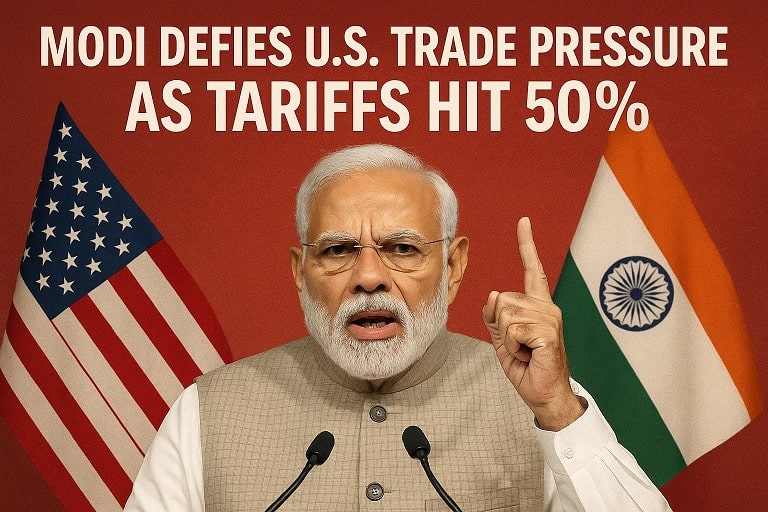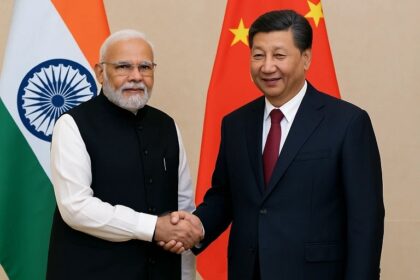Modi Defies U.S. Trade Pressure as Tariffs Hit 50%
In a bold stance against U.S. economic pressure, Indian Prime Minister Narendra Modi has reaffirmed India’s commitment to its national interests, particularly in protecting its farmers and maintaining energy security through continued Russian oil purchases. This defiance comes in the wake of U.S. President Donald Trump’s decision to impose a total of 50% tariffs on Indian goods, a move that has escalated tensions between the two nations. The tariffs, comprising an initial 25% levy announced on July 30, 2025, and an additional 25% penalty on August 6, 2025, target India’s trade practices and its significant imports of Russian oil amidst the ongoing Ukraine conflict.
Background of U.S.-India Trade Relations
India and the United States have historically enjoyed a strengthening partnership, with bilateral trade reaching $190 billion in 2024, making the U.S. India’s largest trading partner. The two nations set an ambitious goal to double this to $500 billion by 2030. However, the U.S. has consistently run a trade deficit with India, amounting to $45.8 billion in 2024, a point of contention for President Trump, who has prioritized reducing trade imbalances. Over the past few months, negotiations for a bilateral trade agreement have been fraught, with key sticking points including India’s protectionist policies, particularly in agriculture and dairy, and its continued economic ties with Russia.
Trump’s Tariff Strategy and Rationale
President Trump’s tariff policy is part of his broader “reciprocal tariffs” initiative, aimed at addressing trade deficits by imposing levies based on a simplistic formula criticized by economists. The formula calculates tariffs by dividing a nation’s bilateral trade deficit with the U.S. by the value of its exports to the U.S., with the U.S. applying half of that result as the tariff rate. For India, this has resulted in a steep 50% tariff, effective August 7, 2025, with an additional penalty for its purchase of Russian oil. Trump has cited national security concerns, arguing that India’s oil imports indirectly support Russia’s military actions in Ukraine. He has also criticized India’s high tariffs on U.S. goods, branding India a “tariff king” and accusing it of unfair trade practices.
Modi’s Defiant Response
Prime Minister Modi has taken a firm stand, emphasizing that India will not compromise on the interests of its farmers, fishermen, and dairy sector. Speaking at the MS Swaminathan Centenary International Conference in Delhi on August 7, 2025, Modi declared, “For us, the interest of our farmers is our top priority. India will never compromise on the interests of farmers, fishermen, and dairy farmers. I know we will have to pay a heavy price for it, and I am ready for it. India is ready for it.” This statement underscores Modi’s commitment to protecting India’s agricultural sector, which employs nearly 44% of the workforce and is a politically sensitive area due to past farmer protests that forced the repeal of agricultural reforms in 2021.
Economic Implications for India
The 50% U.S. tariffs are expected to significantly impact Indian exports, particularly in sectors like textiles, leather, marine products, and electronics, which collectively account for over $85 billion in trade. Small and medium enterprises (MSMEs) in these sectors are likely to face the hardest hit, as competing nations like Pakistan (19% tariff), Vietnam (20%), and Indonesia (19%) benefit from lower U.S. tariff rates. According to the Bank of Baroda, the tariffs could reduce India’s GDP growth by 0.2%, potentially lowering the 2025 growth forecast from 6.6% to 6.4%. In response, the Modi government is urging exporters to develop and promote homegrown brands to mitigate the impact and reduce reliance on subsidies. The commerce ministry is also exploring employment-linked programs to support affected sectors like marine products.
India’s Russian Oil Purchases and Geopolitical Context
A central point of contention is India’s continued purchase of Russian oil, which has grown to approximately one-third of its total oil imports since the Ukraine conflict began in 2022. India defends these purchases as essential for energy security, arguing that it buys oil at the best price to protect its economy and millions of poor citizens. The Indian Ministry of External Affairs has called the U.S. tariffs “unfair, unjustified, and unreasonable,” pointing out that the U.S. initially encouraged India to import Russian oil to stabilize global energy markets. Modi’s government has also highlighted the hypocrisy of Western nations, noting that Europe and even the U.S. continue to engage in trade with Russia despite similar criticisms leveled at India.
Domestic and Political Repercussions
Domestically, Modi faces mounting pressure from opposition leaders who have labeled the U.S. tariffs as “economic blackmail.” Congress leader Rahul Gandhi has accused Trump of bullying India into an unfair trade deal, while Shashi Tharoor called the tariffs a “major blow” to Indian exports. Modi’s emphasis on the “Make in India” initiative, encouraging citizens to buy locally produced goods, reflects a strategy to bolster domestic industries amid global economic uncertainty. At a rally in Uttar Pradesh, Modi stated, “The world economy is going through many apprehensions — there is an atmosphere of instability. Now, whatever we buy, there should be only one scale: we will buy those things which have been made by the sweat of an Indian.”
Diplomatic Tensions and Other Irritants
Beyond trade, U.S.-India relations have been strained by Trump’s claim that he brokered a ceasefire between India and Pakistan following India’s Operation Sindoor in 2025. India has vehemently denied any third-party mediation in its disputes with Pakistan, particularly over Kashmir, which it considers an internal matter. Trump’s hosting of Pakistan’s army chief and the announcement of a preferential 19% tariff rate for Pakistan have further irked New Delhi. Additionally, Trump’s social media outbursts, including calling India’s economy “dead,” have marked a stark departure from the previously warm relationship between the two leaders, who once described each other as “great friends.”
Future of U.S.-India Trade Negotiations
Despite the escalating tensions, both nations are continuing trade negotiations, with a U.S. team expected to visit India on August 25, 2025, to discuss a potential trade deal. India has made concessions, including reducing tariffs on U.S. industrial goods, cars, and alcohol, and allowing companies like Starlink to operate in India. However, the U.S. insistence on access to India’s agriculture and dairy sectors remains a major hurdle, as these are politically sensitive areas for Modi. Analysts suggest that a deal could lower tariffs to the 15-20% range, but India is unlikely to concede on agriculture without significant domestic backlash. The outcome of these talks will be critical for both nations, given their shared strategic interests in countering China’s influence in the Indo-Pacific.
Conclusion
The imposition of 50% U.S. tariffs on Indian goods marks a significant challenge to the U.S.-India partnership, testing the resilience of a relationship built over two decades. Prime Minister Modi’s defiant stance reflects India’s prioritization of its economic sovereignty and the livelihoods of its farmers, even at the cost of strained ties with a key ally. As negotiations continue, the world watches closely to see whether Modi and Trump can bridge their differences or if this trade dispute will further fracture global economic relations. For now, Modi’s “Make in India” call and commitment to energy independence signal a nation prepared to weather the storm of U.S. trade pressure.













